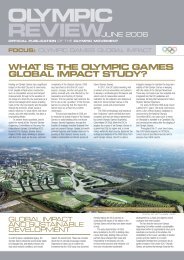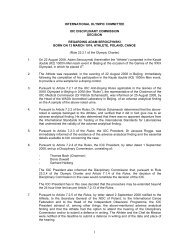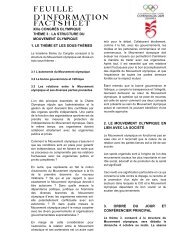7th World Conference on Sport and the Environment - International ...
7th World Conference on Sport and the Environment - International ...
7th World Conference on Sport and the Environment - International ...
Create successful ePaper yourself
Turn your PDF publications into a flip-book with our unique Google optimized e-Paper software.
Report<br />
as well as regi<strong>on</strong>al <strong>and</strong> nati<strong>on</strong>al value. In additi<strong>on</strong>, <strong>the</strong> regi<strong>on</strong> is critically important for <strong>the</strong> survival of<br />
migratory species, including several bird species, cetaceans <strong>and</strong> turtles. However, terrestrial biodiversity<br />
in particular is highly vulnerable to habitat change <strong>and</strong> over-exploitati<strong>on</strong> <strong>and</strong>, as noted previously, <strong>the</strong><br />
Pacific isl<strong>and</strong> regi<strong>on</strong> has been characterized by human-induced extirpati<strong>on</strong> <strong>and</strong> extincti<strong>on</strong>. Ninety percent<br />
of bird species that have become extinct since 1800 were isl<strong>and</strong> species (McIntyre 2005). On a global<br />
basis <strong>the</strong> largest number of documented extincti<strong>on</strong>s (28 between 1600 <strong>and</strong> 1899) has occurred <strong>on</strong><br />
isl<strong>and</strong>s of Oceania, which now have more threatened species (110) than any o<strong>the</strong>r regi<strong>on</strong> (Given 1992).<br />
A recent analysis of global biodiversity hotspots indicates that <strong>the</strong> C<strong>on</strong>servati<strong>on</strong> Internati<strong>on</strong>al designated<br />
Polynesia–Micr<strong>on</strong>esia hotspot) is am<strong>on</strong>g those that can least afford additi<strong>on</strong>al habitat loss because of<br />
previous destructi<strong>on</strong> <strong>and</strong> fragility of ecosystems <strong>and</strong> species (Brooks et al. 2002). Virtually all <strong>the</strong> o<strong>the</strong>r<br />
issues raised in this secti<strong>on</strong> threaten <strong>the</strong> viability of <strong>the</strong> regi<strong>on</strong>’s biodiversity, but especially forest <strong>and</strong><br />
watershed degradati<strong>on</strong>, logging, climate change <strong>and</strong> over-exploitati<strong>on</strong> of marine resources.<br />
However, <strong>the</strong>re is a growing interest by Pacific isl<strong>and</strong> governments to establish protected area systems<br />
<strong>and</strong> also, importantly, by communities who have customary ownership of resources to establish<br />
community c<strong>on</strong>served areas <strong>and</strong> locally managed marine areas (LMMAs). Fiji is leading <strong>the</strong> way in <strong>the</strong><br />
establishment of LMMAs <strong>and</strong> local leaders recently announced plans for <strong>the</strong> protecti<strong>on</strong> of Fiji’s Great Sea<br />
Reef, <strong>the</strong> third l<strong>on</strong>gest barrier reef in <strong>the</strong> world. Similarly, <strong>the</strong> announcement by President Remengesau,<br />
Jr. of Palau in November 2005 called for Micr<strong>on</strong>esian countries to join <strong>the</strong> “Micr<strong>on</strong>esia Challenge” is to be<br />
applauded. Specifically, <strong>the</strong> challenge calls for <strong>the</strong>se countries to effectively c<strong>on</strong>serve 30 percent of near<br />
shore marine resources <strong>and</strong> 20 percent of forest resources by 2020.<br />
5. Energy use<br />
Sustained availability of energy is essential for development <strong>and</strong> human well-being. However, supply of<br />
energy is a problematic issue in PICTs. The Pacific Envir<strong>on</strong>ment Outlook 2005 (McIntyre 2005) reports:<br />
“Despite some positive developments in <strong>the</strong> regi<strong>on</strong>, Pacific Isl<strong>and</strong> countries still face unique challenges<br />
with regard to energy, including: <strong>the</strong> increased pressure of tourism developments <strong>and</strong> urbanizati<strong>on</strong> <strong>on</strong><br />
current energy infrastructure <strong>and</strong> energy supply; high cost of <strong>and</strong> dependence <strong>on</strong> imported fossil fuels<br />
for electricity transport; widely distributed <strong>and</strong> isolated small populati<strong>on</strong> centres; limited awareness <strong>and</strong><br />
acceptance of suitable alternative sources of energy; lack of financially sustainable renewable energy<br />
installati<strong>on</strong>s <strong>on</strong> <strong>the</strong> ground; <strong>and</strong> <strong>the</strong> high initial capital costs for most renewable energy technology. There<br />
is limited awareness of <strong>the</strong> benefits of energy efficiency <strong>and</strong> c<strong>on</strong>servati<strong>on</strong> measures, <strong>and</strong> misc<strong>on</strong>cepti<strong>on</strong>s<br />
over capability of renewable energy because of <strong>the</strong> failures of earlier pilot projects. The c<strong>on</strong>straints to<br />
sustainable energy development are characterized by <strong>the</strong> following issues:<br />
• <strong>on</strong>ly 30 percent of <strong>the</strong> people of <strong>the</strong> regi<strong>on</strong> have access to electricity;<br />
• <strong>the</strong>re is heavy reliance <strong>on</strong> imported fossil fuel;<br />
• <strong>the</strong>re is a lack of comprehensive adopted energy policies <strong>and</strong> plans; <strong>and</strong><br />
• <strong>the</strong>re is a lack of qualified, experienced <strong>and</strong> committed isl<strong>and</strong> nati<strong>on</strong>als”.<br />
6. Adaptati<strong>on</strong> to <strong>the</strong> c<strong>on</strong>sequences of climate change<br />
The Intergovernmental Panel <strong>on</strong> Climate Change (IPCC) has found that global mean surface temperatures<br />
have increased between 0.3°C <strong>and</strong> 0.6°C since <strong>the</strong> late 19th century, <strong>and</strong> predicts that <strong>the</strong> average<br />
temperature may rise by 1.4°C-5.8°C by 2100. Although <strong>the</strong>re is still c<strong>on</strong>siderable uncertainty in <strong>the</strong><br />
scale of predicted changes <strong>on</strong> <strong>the</strong> basis of measured change, modelling <strong>and</strong> forecasting, it is clear<br />
that we need to adopt <strong>the</strong> precauti<strong>on</strong>ary principle in dealing with climate change issues. It is likely that<br />
climate change will bring fur<strong>the</strong>r changes to global temperatures, precipitati<strong>on</strong> patterns, sea level <strong>and</strong><br />
<strong>the</strong> distributi<strong>on</strong> <strong>and</strong> intensity of extreme events to all corners of <strong>the</strong> globe. In its third report in 2001, <strong>the</strong><br />
IPPC c<strong>on</strong>firmed <strong>the</strong> threat to isl<strong>and</strong>s from increasing sea levels <strong>and</strong> o<strong>the</strong>r aspects of climatic change. The<br />
Millennium Ecosystem Assessment (MEA) (2005) reports that observed impacts of climate change have<br />
already included:<br />
• changes in species distributi<strong>on</strong>s <strong>and</strong> populati<strong>on</strong> sizes;<br />
• changes in <strong>the</strong> timing of reproducti<strong>on</strong> or migrati<strong>on</strong> events;<br />
• increase in <strong>the</strong> frequency of pest <strong>and</strong> disease outbreaks; <strong>and</strong><br />
• that many coral reefs have underg<strong>on</strong>e major, although partially reversible, bleaching episodes when<br />
local sea surface temperatures have increased.<br />
The MEA has c<strong>on</strong>cluded that by <strong>the</strong> end of <strong>the</strong> century, climate change <strong>and</strong> its impacts may be <strong>the</strong><br />
dominant direct driver of biodiversity loss <strong>and</strong> changes in ecosystem services globally. Maintaining<br />
ecosystem services, in turn, is essential for achievement of <strong>the</strong> Millennium Development Goals by 2015<br />
<strong>and</strong> bey<strong>on</strong>d. Critically, <strong>the</strong> impacts of climate change magnify <strong>the</strong> impacts of o<strong>the</strong>r human-induced<br />
changes, such as deforestati<strong>on</strong>, over-fishing <strong>and</strong> polluti<strong>on</strong>, increasing <strong>the</strong> species extincti<strong>on</strong> crisis that we<br />
already face. In a recent analysis, WWF (2003) has categorised <strong>the</strong> types of climate change impacts <strong>on</strong><br />
natural systems:<br />
<str<strong>on</strong>g>7th</str<strong>on</strong>g> <str<strong>on</strong>g>World</str<strong>on</strong>g> <str<strong>on</strong>g>C<strong>on</strong>ference</str<strong>on</strong>g> <strong>on</strong> <strong>Sport</strong> <strong>and</strong> <strong>the</strong> Envir<strong>on</strong>ment<br />
Internati<strong>on</strong>al Cooperati<strong>on</strong> <strong>and</strong> Development Dept.<br />
Page 97/256
















